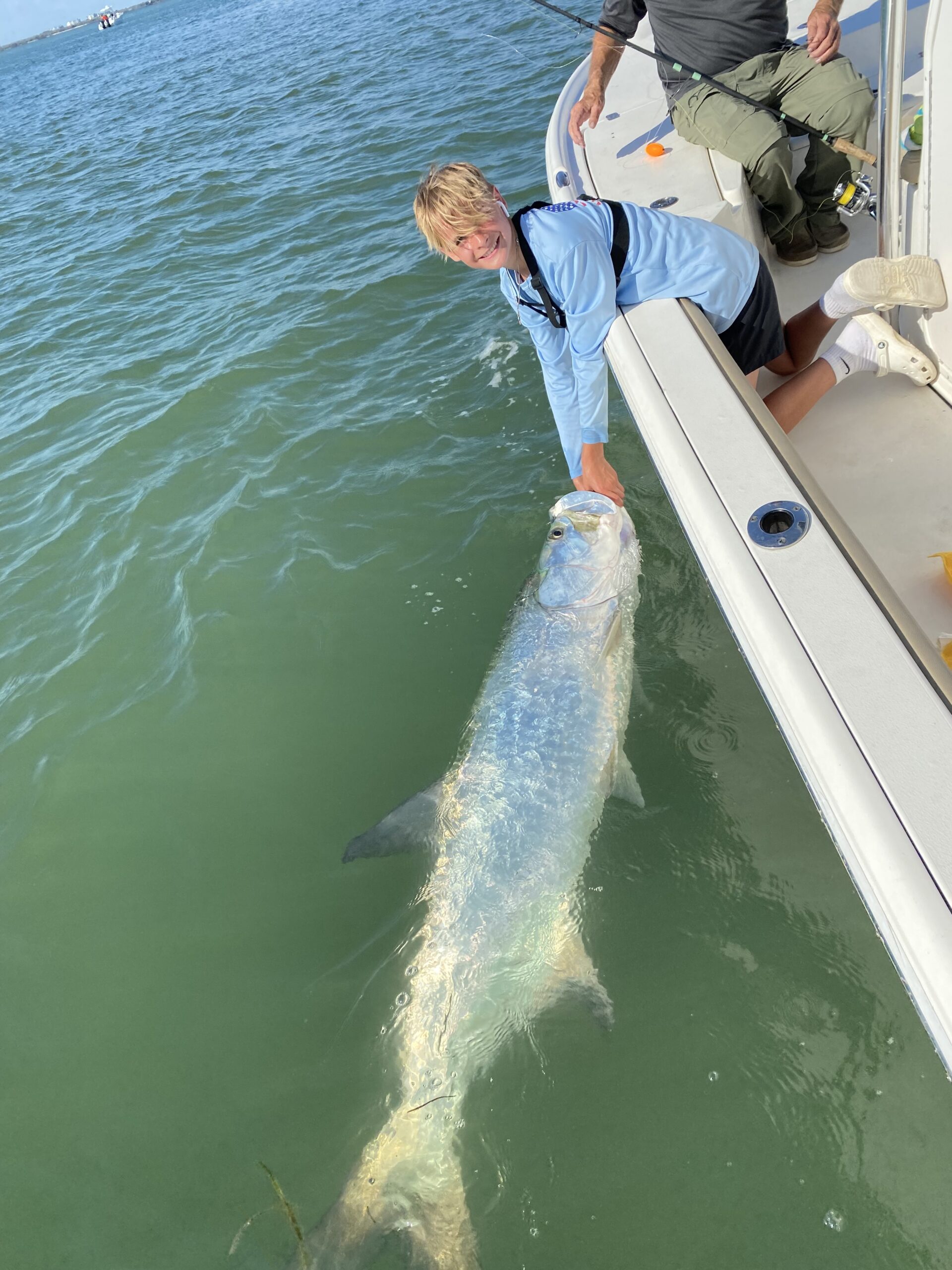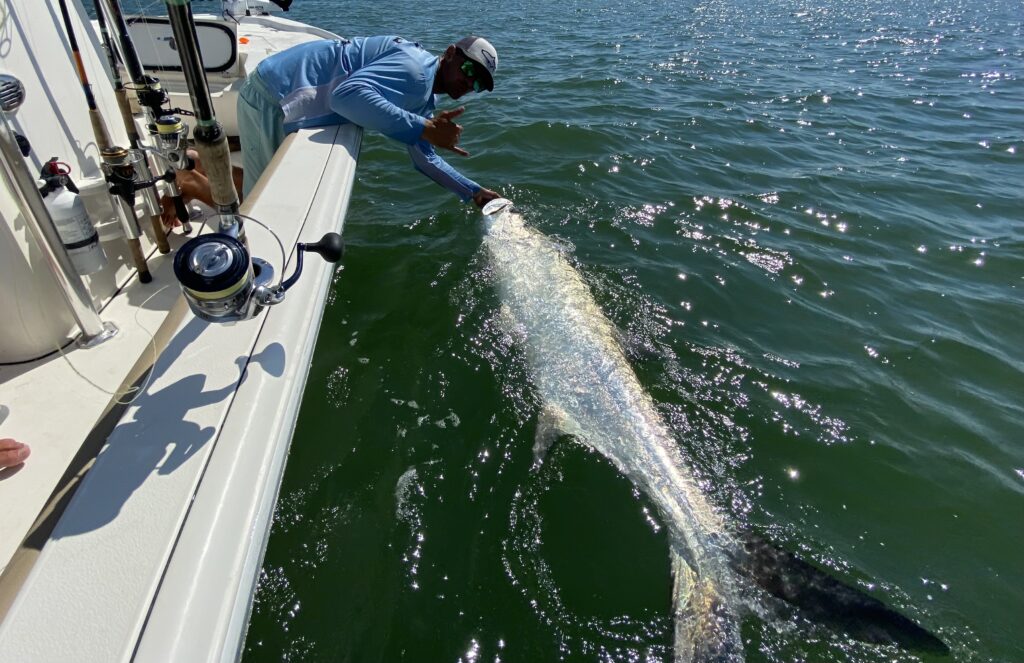Tarpon Fishing Fort Myers: Thoughts From A Guide
There’s nothing quite like tarpon fishing in Fort Myers!
It’s my favorite species to target and nothing beats putting clients on their first or biggest tarpon on our charters. Every year, as the warm waters of the Gulf come alive with migrating Silver Kings, I find myself counting down the days until I can chase these incredible fish again. The explosive strikes, the aerial acrobatics, and the sheer power of a hooked tarpon make it my favorite time of year.
Whether you’re a seasoned angler or new to the sport, there’s something special about the challenge and excitement of tarpon fishing. And don’t let it intimidate you… I’ve spent countless hours on these waters, learning what works, what doesn’t, and how to make the most of every trip. In this write-up, I’m excited to share my passion, experience, and insider tips as a Fort Myers tarpon fishing guide to help you become a more prepared tarpon fisherman.
What Makes Fort Myers A Tarpon Fishing Hotspot
Fort Myers is a premier tarpon fishing hotspot thanks to its prime location along the annual tarpon migration route and its abundance of ideal habitat. Each spring and summer, thousands of tarpon migrate north from the warm waters of the Florida Keys and Caribbean, following the bait-rich currents along Florida’s Gulf Coast. As they move through the region, Fort Myers serves as a natural stopping point due to its combination of deep channels, estuaries, and shallow flats. The Caloosahatchee River, Pine Island Sound, and the passes around Sanibel and Captiva Islands create a perfect environment for tarpon to rest, feed, and stage before continuing their journey. These waters are teeming with baitfish such as mullet, threadfin herring, pilchards, and crabs—prime food sources that draw tarpon in large numbers. The strong tidal flow through Boca Grande Pass, known as the “Tarpon Capital of the World,” concentrates fish in predictable areas, making it one of the most productive places to target them. Whether feeding on the surface at sunrise, cruising along the beaches in schools, or stacked up in deep channels, we’re always provided with numerous opportunities on our tarpon fishing charters to put clients on fish.

An Area Rich In Tarpon Fishing History
Fort Myers, Florida, is known as the birthplace of modern tarpon fishing, with its waters playing a pivotal role in establishing tarpon as a premier gamefish. The sport was revolutionized in 1885 when William H. Wood caught the first recorded tarpon while fishing near Sanibel Island, proving the fish’s incredible strength and fighting ability. Obviously – word spread quickly, which attracted wealthy anglers from across the country and even overseas putting Fort Myers on the map as a major sportfishing destination. The rise in tarpon fishing led to a tourism boom, with the construction of hotels, fishing lodges, and guide services catering to visiting sportsmen eager to battle the Silver King.
As tarpon fishing gained popularity, innovations in tackle and techniques emerged, and catch rates went up. Conservation efforts became crucial as fishing pressure increased, leading to protective regulations such as mandatory catch-and-release for large tarpon. I’m proud to say Fort Myers played a key role in these initiatives, with local anglers, charters, organizations, and researchers working together to ensure the fishery’s sustainability. It seems to have worked – because Fort Myers remains a world-class tarpon fishing destination with great fish populations and a great community of tarpon fishing guides.
Fort Myers Tarpon Fishing Migration Patterns
Fort Myers is perfectly positioned within the tarpon migration route, making it one of the most reliable locations to target these fish. The region’s extensive network of backwaters, bays, and nearshore Gulf waters provides ideal habitat for tarpon throughout much of the year. The annual tarpon migration ensures a consistent influx of fish, offering our charter guests excellent opportunities to feel their power. Fort Myers is home to diverse fishing environments, ranging from the Caloosahatchee River to Pine Island Sound and the open Gulf. The area also boasts an abundance of baitfish, including threadfin herring, mullet, and crabs, which serve as a constant food source for tarpon. My personal favorite is when we get sight fishing opportunities – where we can see tarpon rolling on the surface or cruising the shallows before casting to them. Talk about getting your heart pumping!
Best Season for Tarpon Fishing in Fort Myers
The best time for tarpon fishing in Fort Myers depends on the seasonal migration. While some tarpon hang out in the area year-round, the peak season occurs in late spring and early summer. During the winter months, tarpon hold in deeper, warmer waters such as rivers and channels. Spring marks the beginning of their movement into estuaries and nearshore waters as temperatures rise, with large schools arriving by April. Summer is the prime season, when massive numbers of tarpon gather along the beaches, in passes near Sanibel and Captiva Islands, and throughout the bays. This is when charter guests experience the most explosive action, particularly with live bait techniques. In the fall, tarpon begin to disperse but can still be found in the region’s backcountry and river systems before cooler temperatures push them into winter patterns.
Most Productive Fort Myers Tarpon Fishing Spots
Fishing for tarpon in Fort Myers can be done in a variety of locations. Pine Island Sound provides an estuarine habitat perfect for tarpon throughout the season, while the beaches of Sanibel and Captiva Islands offer excellent opportunities for sight fishing. The Caloosahatchee River is another solid location, especially in winter and early spring when tarpon seek refuge in its warmer waters. The bridges and passes around Cape Coral and Matlacha Pass are also productive hot spots, particularly when changing tides are moving bait through the area. Our tarpon fishing charters fish all over the area, and we typically don’t decide where we’re fishing until the night before a planned charter just based on recent reports and seasonal factors.
How We Catch Tarpon With Our Clients
There are several effective methods for catching tarpon in Fort Myers using light tackle. On our tarpon charters, live bait fishing is probably our most effective technique, with clients using crabs, mullet, threadfin herring, and pinfish. Drifting live bait near passes or freelining bait near bridges and backwaters works really well. Artificial lures also produce great results, with soft plastic swimbaits, DOA Bait Busters, and topwater plugs being some of my personal favorites. Many local anglers prefer using medium-heavy spinning gear with 30- to 50-pound braided line and fluorocarbon leaders in the 60- to 80-pound range to handle tarpon’s abrasive mouths and powerful runs. When using lures, working them with a steady retrieve or a twitch-pause technique can trigger aggressive strikes from tarpon willing to chase. This is super exciting especially when you can spot the tarpon first!
How Big Do Tarpon Get In Fort Myers?
The tarpon we’re typically catching in the Fort Myers area range in size from juveniles around 10 to 30 pounds in the backwaters to massive adult fish exceeding 150 pounds in the Gulf and passes. The average tarpon caught in the region typically falls between 80 and 120 pounds, though larger fish over 200 pounds have been recorded. Some of the biggest tarpon ever landed in Florida have come from the waters near Fort Myers, with fish pushing the 220-pound mark. While the official IGFA world record tarpon stands at 286 pounds, Fort Myers consistently produces trophy-sized fish that rival some of the biggest caught anywhere in the world. I guess I can thank my parents for setting up shop here!
Tarpon Fishing Regulations & Conservation
Regulations and conservation efforts play a critical role in maintaining Fort Myers’ world-class tarpon fishery. As a Fort Myers tarpon fishing guide – conservation isn’t just something I believe in, it’s something we depend on to be able to continue sharing these experiences with anglers.
Florida law mandates that all tarpon over 40 inches must be released immediately unless an angler has purchased a special Tarpon Tag, which is only issued for those seeking an IGFA record. Gaffing tarpon is prohibited, and anglers are encouraged to handle fish with care, keeping them in the water whenever possible to reduce stress and injury. The use of non-offset circle hooks is required when fishing with live bait to minimize deep hooking. Conservation organizations such as the Bonefish & Tarpon Trust (BTT) and the Florida Fish & Wildlife Conservation Commission (FWC) are actively involved in habitat protection and tarpon research. Tagging programs help track migration patterns, and angler participation in proper handling practices ensures these fish are around for generations to come.
Hopefully This Helps
If you’ve made it this far, it shouldn’t take much convincing. Might sound cliche, but tarpon fishing in Fort Myers really is an unforgettable experience. Clients who fish with us are typically talking about their next trip right away. The thrill of hooking into a 100+ pound tarpon, feeling the power of that first run, and watching it leap into the air is unmatched. If you’re planning a trip, try to go during peak migration, use the right gear, and respect conservation efforts to ensure these incredible fish continue to thrive. Get in touch with me to talk about tarpon fishing charters, I’m happy to help answer any questions you may have ahead of booking!
Fish With Capt. Jack Swedberg
Jackpot Fishing & Ecotours offers back bay trips for shallow water species, nearshore fishing for permit, snapper, sharks, & more, tarpon fishing charters, and night fishing charters for whatever’s biting!
Our charters start out of Sanibel/Fort Myers Beach area with convenient waterfront pickups also available. Captain Jack has poured 15 years of passion into these waters and loves putting his clients on fish!
Call/text Captain Jack Swedberg for daily availability.

